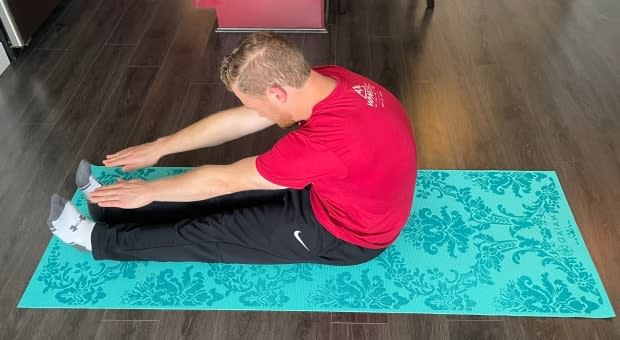Take 2 steps and call me in the morning: Exercise as a prescription for depression

Judy Mulloy's voice breaks and her eyes well up with tears as she describes how a simple walk in the park and chair yoga has helped her through the pandemic.
"Oh, it's a happy cry, I assure you," she said. "My life has changed around. It's no longer a thing of sadness."
Mulloy, 56, first turned to physical activity years ago to manage her depression. She says staying active in her hometown of Nelson, B.C., hasn't eliminated her need for a daily antidepressant.
"But the thing that can boost my mood is to go for a walk. Go for a swim. Do some exercise," she said.
That tonic began to dry up when the first COVID-19 lockdown hit in 2020 and gyms and recreation centres were shuttered. Mulloy responded to a social media post looking for volunteers for a study that replaced facilities and classes with a commercially available app.
"I've not looked back. It's been amazing," she said.

Anxiety, depression increased in pandemic
The study was conceived by Eli Puterman, an associate professor and Canada Research Chair in Physical Activity and Health.at the School of Kinesiology at the University of British Columbia in Vancouver.
Puterman says he was moved by surveys such as the poll done for Mental Health Research Canada in early 2020, which suggested anxiety levels had quadrupled and depression levels doubled during the pandemic.
"People were suffering. So, we wanted to see whether we can support people," Puterman said.
His research team recruited over 300 people, gave them a free subscription to an exercise app and divided them into four randomized groups that either did yoga, high-intensity interval training, a combination of the two, or were relegated to a wait list.
Each week, participants completed a standard questionnaire that's used in the diagnosis and treatment of depression. Using a scale of zero to three, people reported how often they experienced symptoms such as sleeplessness or feeling lonely.
The results were reported in the British Journal of Sports Medicine last fall.
"Everyone dropped in their depression levels," Puterman said.
WATCH | Judy Mulloy talks about the exercise benefits she experienced:
While none of the participants were screened to determine whether they had been diagnosed as clinically depressed, of those who were active in the study, the ones who reported the most severe symptoms at the start showed the biggest improvement, Puterman said.
"I am surprised by how drastic of an effect it was," he said.
Past studies show similar results
Puterman's results are only the latest to link physical activity and mood. "There's been enough studies," said Vancouver psychiatrist Dr. Ron Remick.
Remick thinks physical activity can be as effective as some more common treatments for depression, such as psychotherapy or antidepressants. But while it's true that research going back decades demonstrates the ability of exercise to measurably reduce symptoms of depression and stave off relapse, on its own, it may not be enough to treat severe depression, a complex disease that can have multiple causes.

Remick's advocacy for movement as medicine comes from his own experience. Seven years ago, as medical director of the Mood Disorders Association of British Columbia he pioneered a weekly program of low-impact movement for his patients called Jump Step.
It involved outdoor walks, floor exercises and cardio routines combined with a group medical visit.
When the pandemic struck, the program went virtual. Participants were given the only equipment they'd need: a yoga mat and an exercise band. Jump Step now runs for eight weeks, four times a year. Its results have drawn attention from the B.C. government, which was interested in potentially implementing it provincewide.
"Much like our earlier research, it has continued to show that a significant number of people who do a program like this have significant improvement in their depressive symptoms," Remick said.
'A break from all of that chatter'
Michael Sarvari leads the weekly classes. Sarvari draws on his own experience as someone who wrestled with severe depression for most of his life until one day, he says, he crawled out of bed and convinced himself to do a pushup. The next day he tried two, and so on.

"When you're depressed, your mind is so busy with negative thoughts and chatter," Sarvari said.
"When you kind of take yourself out of your mind and into your body doing physical things, you get a break from all of that chatter. It kind of creates that calm within yourself."
Sarvari says it's hard to overstate the benefits of basic, regular physical activity
"I could be homeless because I wasn't able to support myself. I wasn't able to work," he said. "I would be in a very dark place and possibly not alive because I was suicidal for many years."
WATCH | Dr. Ron Remick outlines why a little movement goes a long way:
Researchers are hoping to ease that kind of personal suffering while acknowledging there's a payoff for the wider public if they're successful. A decade ago, the World Economic Forum and the Harvard School of Public Health forecast the global cost of mental health conditions by 2030 to be over $7 trillion a year.
"Changes occur slowly in medicine even when the evidence is there for a long long time," said Remick.
Unlike a pill, prescribing exercise has to be tailored to a patient's abilities by doctors who know how to motivate people.
Puterman says while there is ample evidence to support his broader findings, some research gaps remain. Most of the participants in his study were white and maintained their jobs during the pandemic. He plans to focus a future study on more diverse and vulnerable communities.


